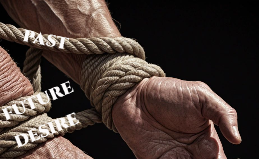The Illusion of the Rope: A Stoic Guide to Mental Freedom
Posted by Cato Pine on Sep 26th 2025
On the tombstone of the great writer Nikos Kazantzakis is a simple, profound epitaph: "I hope for nothing. I fear nothing. I am free."
For Kazantzakis, this wasn't a statement of despair, but one of ultimate liberation. He understood that so much of our mental energy is spent grasping at invisible ropes—the rope of expectation for a specific future, the rope of fear of what might go wrong. He found freedom not by achieving all his desires or banishing all his fears, but by realizing he could simply… cut the rope.
How many of these invisible ropes are holding you back right now? Think of the subtle tension you feel when a news headline flashes across your screen, the knot in your stomach before a difficult conversation, or the dull ache of a past regret that surfaces in a quiet moment. We feel tethered, pulled in a thousand directions by forces that seem beyond our command.
But what if, like Kazantzakis, we could see these ropes for what they are? What if we held the tool to sever them?

The Three Strands That Bind Us
These illusory ropes are often woven from the same three strands. When we feel stuck, anxious, or frustrated, it's usually because we are entangled in one of them.
- The Rope of the Past: This is the strand of resentment and regret. We are bound by it when we endlessly replay a mistake, nurse an old grudge, or lament a path not taken. It keeps our focus anchored to a time we cannot change, draining our energy for the present.
- The Rope of the Future: This is the heavy strand of anxiety and worry. We are caught in its grip when we catastrophize about what might happen—in our career, our health, our relationships. We live in a future that doesn't exist, tethered to outcomes we can't guarantee.
- The Rope of Desire: This is the most subtle strand—the craving for things outside our direct control. It’s the desperate need for someone’s approval, the attachment to a specific outcome, or the belief that our happiness depends on acquiring a certain status or possession.
The Blade That Sets You Free: The Dichotomy of Control
So, how do we cut these ropes? The Stoics offered a tool so simple and sharp that it can slice through any of these illusions with a single, clarifying thought. This tool is the practice of differentiating between what is up to us and what is not.
Epictetus, a former slave who became one of Stoicism's most influential teachers, put it this way: "Some things are within our power, while others are not."
- Within our power: Our judgments, our intentions, our responses, the actions we choose to take.
- Not within our power: Everything else. The weather, the economy, how other people behave, the final outcome of our efforts, our reputation.
This isn't a call for passive resignation. It is the ultimate empowerment. It’s a blade that allows you to see that the ropes tying you to the past, the future, and the desires you can't control aren't actually attached to you; they are attached to things external to you. By focusing your energy entirely on what is within your power—your next virtuous action, your reasoned response—you aren't waiting for the ropes to weaken. You are actively making the cut.
Your Practice: Identify and Cut the Rope
Wisdom is not meant to be admired; it's meant to be used. The next time you feel that familiar pull of anxiety, anger, or frustration, don't just endure it. Take out a notebook and use your blade.
1. Identify the Situation: Write down the one thing that is causing you mental turmoil right now. Be specific. (e.g., "I am anxious about an upcoming presentation at work and afraid my boss won't be impressed.")
Separate the Strands: Draw a line down the middle of the page.
-
On the left side, list every aspect of this situation you can control. (e.g., How thoroughly I prepare. The mindset I bring. Practicing my speech. Focusing on delivering value.)
-
On the right side, list every aspect you cannot control. (e.g., The final reaction of my boss. Whether a colleague is having a bad day. The Wi-Fi connection in the conference room.)
2. Cut the Rope: Look only at the left column. From that list, choose one single action you can take right now. This is your focus. This is where your freedom lies. Write it down: "My next action is to spend 25 minutes refining my opening slide."
This practice transforms you from a victim of circumstance into an architect of your response.
Freedom isn't a distant destination you arrive at once all your problems are solved. It is a daily practice of seeing the rope, picking up the blade, and making the cut.
A dedicated space for this work can transform it from an occasional thought into a daily habit. The Citadel Journal is designed for precisely this kind of clarifying work, providing a structured place to separate what you can control from what you cannot.
Pick up your pen. Find your blade. Cut the rope.


